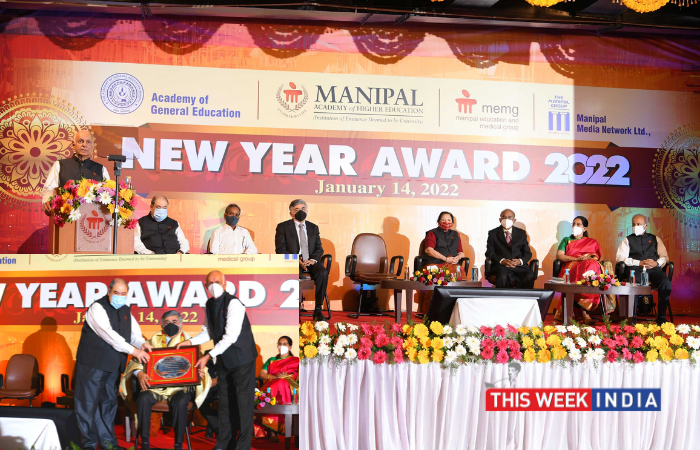In one form or the other, individual life styles are directly responsible for greenhouse gas emissions. The collective and cumulative effect of unsustainable life styles is the heating of the earth’s atmosphere While the Governments around are making efforts through policies towards Energy Transition, we as individual indeed to act by adopting a sustainable life style. Some simple acts like less consumption of electricity and water, avoiding wastage, using public transport, adopting recycling and reuse, installing rooftop solar and switching over to EVs etc would help.
In an exclusive interview with This Week India, Mr Baroruchi Mishra, group CEO, NET Enterprise, a leading EPCM, PMC and engineering services provider in oil & gas and energy transition areas such as biofuels, carbon capture, plastic circularity and green hydrogen, suggested this and much more on World Earth Day
TWI : Apr 22 is the World Earth Day. What is the significance of observing the World Earth Day.
Baroruchi Mishra: Initiated by the US Senator Gaylord Nelson, the World Earth Day was first celebrated on April 22, 1970 in the US to honour and strengthen the environmental movement and raise awareness about the need to preserve our environment, and about sustainable development.
Millions of people attended the World Earth day across the US; the movement helped garner support for the Clean Air Act (1970 ) in the US. It created a global platform (EDN –Earth Day Network) that brings people together for environmental policy advocacy and for raising awareness about the irreversible harm that unsustainable life styles were causing to Mother Earth.
I see this as a start of the climate activism that helped mobilize (and unite) global efforts towards actions to prevent climate change. Many environmental legislations came in its wake, which all culminated in signing of the Paris Agreement ( under the United Nations Framework Convention on Climate Change , UNFCCC) on 12th of Dec 2015 by 175 countries (174 countries plus the EU). The Paris Agreement is a watershed event in the planet’s efforts towards saving itself from extinction!
Every year this day serves as a grim reminder of the fact that Earth needs listening to. Mother Earth is telling us – “I am your sink. Plant a tree, preserve my vegetation cover and my corals, don’t mindlessly mine me, don’t smother my ability to absorb by covering me up with plastics and I will keep the CO2 within limits for you! And , as a bonus, I will afford you pore spaces in my rocks for you to store your excess CO2 so that you can wash your past sins of unsustainable development!”
TWI : How can individuals play a role in mitigating global warming?
BM : In one form or the other, individual life-styles are directly responsible for greenhouse gas emissions. The collective and cumulative effects of unsustainable life styles have resulted in heating up the earth’s atmosphere. John Nolt, a professor at the University of Tennessee, estimated in 2011 that a typical American in his lifetime of 70-80 years might have been responsible for one or two deaths due to the CO2 emissions from his or her life style!
While the Governments around the world are making efforts through policies towards Energy Transition, we as individual need to act by adopting a sustainable life style. Some simple acts like less consumption of electricity and water, avoiding wastage, using public transport, adopting recycling and reuse, installing roof-top solar and switching over to EVs etc would help.
In addition, and without sounding controversial, may I say that changes in our food habits would help. Adopting a more vegetarian plate will help stave off the CO2 emissions that come in the wake of preparing a meat platter. Plant based products have an order of magnitude lower CO2 intensity than meat products. However, this is a personal choice which has to be respected as such.
In India, the per capita CO2 emission is 2 tonnes per annum (America 15 tpa, China 8 tpa). We can create offsets for this carbon emission by planting trees. A single mature tree can sequester up to 22 kg of CO2 annually. Theoretically, therefore, planting 100 trees per year per person would offset individual carbon emissions for Indian citizens in due time if 2 tpa per capita CO2 emission stays where it is. Let us plant more than 100 trees every year so that we can be sure that atleast 100 survive long term.
As individuals, we can raise awareness among our fellow citizens about the perils of global warming and climate change. This would help in changing life-styles. This might also increase the willingness to pay more for lower-carbon-intensity products which in turn would help finance the efforts being made by the manufacturing companies to reduce their CO2 foot-prints by investing in Net Zero Technologies.
TWI : Over the years, what notable changes have you observed annually as we celebrate World Earth Day?
BM : Our employees are more informed and aware. They have started believing in the catastrophic impacts of climate change by what they see happening around them – water crisis in Bangalore, the recent Dubai deluge , floods in Europe , Pakistan and China and other catastrophic environmental events globally which are all increasing in their frequency.
People are concerned. However, in India, we have a problem – our risk perception threshold as a population is very high. Not until the water comes up to the nose do we think that we might drown. This needs to change; we need to be a bit paranoid (in a positive sense) towards what could go wrong and then prepare for it so that we can avert the danger in time.
We still have to make the climate change narrative less esoteric and spread it a manner that the common person is willing to sit up and take note, and indeed act.
TWI : With the rise in temperature every year, what are the challenges in protecting our planet?
BM : 2023 was the hottest recorded year in human history – the average global temperature for 2023 was 1.48°C above the pre-industrial average.
The disturbance in the balance of the ecological system – earth, oceans and the atmosphere is making the future not only unsustainable but also unpredictable. The meteorological models , however sophisticated , often fail to forecast the intensity, scale and impact of catastrophic environmental events. This will indeed be the real tests of Artificial Intelligence! One would have wished that the Dubai Deluge was predicted to the level of what actually happened!
Loss of biodiversity further weakens our defences against climate change. When the oceans heat up beyond what the corals can take, we will have lost the barriers that nature has a given us to prevent costal storms!
Billions of dollars, which could have otherwise been gainfully deployed to take climate actions, are lost in fighting forest fires engendered by climate change.
When the wet bulb temperature starts to get to 35 deg C, our body’s biological defence mechanisms to keep itself cool by perspiring breaks down, and death by heat strokes become common. In many parts of India, we have started seeing this kind of temperature and humidity!
Every passing year without action or with failed action to prevent climate change, every fatalistic rhetoric about nothing would happen to us as God looks after us, will impose unsurmountable challenges in protecting our planet.
TWI : How can businesses observe World Earth Day and implement strategies to positively impact the environment?
BM : On the World Earth Day , all business (especially those in the Oil and Gas, Manufacturing and Power sector) should set science based NET Zero Targets or revisit them if they have already set the targets. The targets need to be credible and the schedule to achieve them should be resource loaded. There are many corporates who have just gone about setting a target date for getting to Net Zero without realising how they would ever be achieved; these are like unfunded tax cuts, which provide a false sense of relief and security in the short term!
Many large corporates (and emitters) use Climate Action 100+ (CA100+) benchmarks to check if their NET ZERO plans are credible.
Every year on the Earth day, the corporates should take stock of their progress on the plan versus actual towards achieving their Net Zero Goals. If needed , they should re-baseline their plans or prepare a recovery schedule to catch up on the time lost but it has to be honest.
Finally, Businesses should reconfirm their commitment to the four Meta-Criteria for Net Zero realisation: Pledge (or re-Pledge), Plan, Proceed and Publish.
TWI : What specific initiatives does Nauvata Energy Transition (NET) Enterprise, as a company has undertaken for World Earth Day within its office environment?
BM : Let me list down a few simple initiatives that we are taking in our office :
- Minimisation of water use and paper use: We measure the amount of paper tissues being consumed by the staff and send out messages to raise awareness about eliminating wastage.
- Encouraging our staff to use metro train service. We have arranged pick up and drop to the metro station for our staff.
- Optimise the use of ACs in the office to maintain right levels of cooling without wasting electricity.
TWI : As a leading consultant in the oil & energy segment, how does NET Enterprise contribute towards reducing carbon footprint for its clients?
MB : We are building capabilities to support efforts by the Government and the Industry to meet their Net Zero Targets. It is apparent that under all scenarios for limiting 2 deg centigrade rise , CCUS ( Carbon Capture and Storage or Sequestration) will be key. So we are creating capability in the CCUS value chain.
We are delivering a carbon capture project as an EPCC (Engineering, Procurement, Construction and Commissioning) for HPCL using their patented Hi-Gas Unit Technology which promises to reduce the Capex related to Carbon Capture significantly. This will be a key enabler for carbon capture in India ; high carbon capture cost is a big deterrent for companies in hard to abate sectors– Power, Cements , Refineries, Fertiliser and Steel , to capturing their CO2 emissions and using them to make products – Methanol, Ethanol etc..
Storage is still not available in India. However, we have forged an international partnership with a company that has expertise in Subsurface and Wells aspects of Carbon Storage in saline aquifers or depleted oil and gas fields. We can now help corporates undertake the full CCUS project scopes to reduce their Scope 1 and Scope 2 CO2 emissions.
Under a Not- for-Profit endeavour, we are preparing to help Living Peace Projects, Netherlands, to undertake cleaning up of a 50 km stretch of the Yamuna River in Mathura , and to build water Harvesting and Sanitation structures on its Ghats. The project is in the early stages and is working towards achieving financial closure. This will be done in partnership with the government.
Plastic Circularity: NET Enterprise has singed an MOU with the Government of Uttarakhand to build a plant for chemical re-cycling of single-use and multi-layer plastics which generally end up in the land-fills. The product of this process is purified pyrolysis oil that meets Craker Feed specs of a refinery and is a credible bitumen blend.
Finally, NET Enterprise has formed a Joint Venture with dDriven – a company which provides Industry 4.0 solutions for digitalization, data analytics, remote monitoring and diagnostics, digital twins etc. Digitalisation / Digitisation helps with productivity improvement and improvement in efficiency across any business process by inducing greater Energy Efficiency and/or engendering data driven decision making. Improvements in efficiency in manufacturing and other business processes will contribute to 20-30% reduction in CO2 footprints globally in the years to come.









